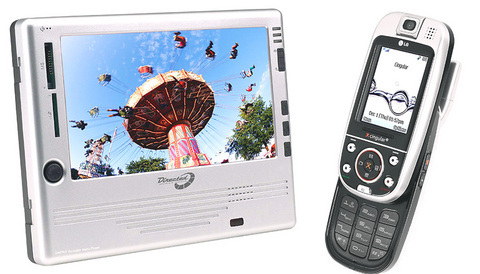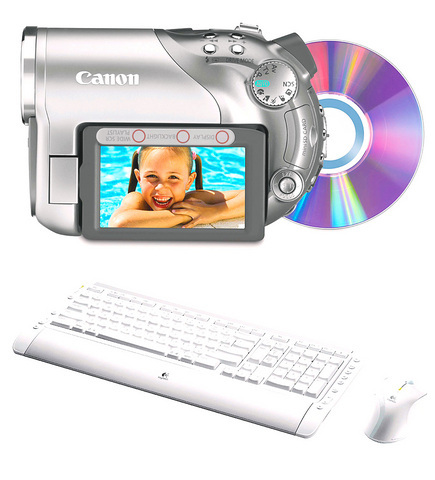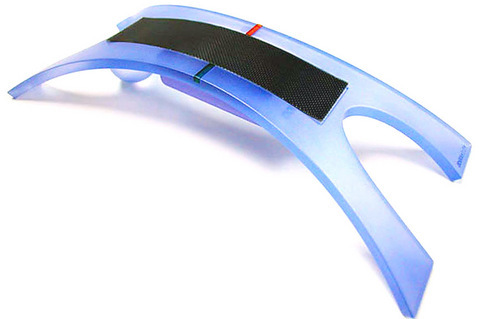If you have a short attention span, LG Mobile has the phone for you. The CU320 handset has a multitask button so that voice and data features can be used at the same time. Users can chat while text-messaging, looking up sports scores or browsing the Web.
The CU320 was made to be used with the new 3G high-speed data service, which lets subscribers download video clips of news and entertainment.
If doing two things at once isn't enough, the phone offers other amusements, like a 1.3-megapixel camera with a 4X zoom and photo editing software that lets you crop shots and add text right on the phone.

PHOTO: NY TIMES NEWS SERVICE
The camera also has a video function that can record up to 25 minutes of low-quality video (or five minutes at the highest-quality setting). A card can be added for more memory.
The phone also has a stereo MP3 player and personal organizer functions. If all that doesn't keep you entertained, you could just call someone interesting.
When Steven Jobs introduced the Mac Mini, he expected customers to bring their own keyboard and mouse. But many keyboards -- salvaged from old family PCs -- clash with the look of Apple's austere products. The Logitech S530 addresses that issue handily.

PHOTO: NY TIMES NEWS SERVICE
This 1.9cm thick keyboard and mouse combo comes in blinding white and is cordless. Both the mouse and the keyboard connect to the computer via an unobtrusive USB receiver.
Logitech has included some nice features just for Mac users, including separate iTunes, iPhoto and Spotlight search buttons. There is also a dedicated Mail button, as well as dedicated scroll buttons for viewing Web pages.
The mouse has five programmable buttons and a scroll wheel that tilts from side to side for easier Web browsing and document editing.

PHOTO: NY TIMES NEWS SERVICE
The mouse requires two AA batteries and the keyboard requires two AAA batteries. Battery life is about six months. When they begin to fail, the keyboard and mouse both flash, and they will last 10 days before dying completely.
With its 17.8cm screen, which is fairly large as personal media players go, the DMP740 dockable media player from Directed Electronics can be used as a stand-alone device. But when docked to a mobile monitor in a car, it can show images on a screen as large as 43cm.
The player operates with overhead monitors from Directed, which are available in five screen sizes from 22.8cm to 43cm, or it can be swapped for the removable DVD player in the company's all-in-one overhead video system. Directed video systems and the DMP740 are sold through car electronics dealers and installers.
The player has a 40-gigabyte hard drive that holds up to 160 hours of video (in DivX, MPEG4, WMV and AVI formats), up to 10,000 MP3 or WAV music files, or as many as 200,000 digital images. That content can be loaded through the player's USB 2.0 port, AV input and output jacks, or built-in SD/MMC and Memory Stick card readers.
Few car trips are long enough to exhaust the DMP740's capacity. So there will be plenty of content to enjoy when it is taken out of the car to resume life as a portable player.
Direct-to-DVD video cameras have been around for a bit, but Canon will soon introduce a model that has some interesting new features. The DC40 records up to 60 minutes of video to 7.5cm DVD-R/RW disks and can take 4.3-megapixel still pictures.
The DC40 records in wide-screen (16:9 aspect ratio), so broad vistas won't get cut off. The camera's 6.9cm color LCD screen matches this wide-screen ratio, ensuring you see everything that will be captured onto DVD.
Instead of fast-forwarding or rewinding, the camera lets you view each clip as it is recorded. The camera can take snapshots even while recording video, storing still shots to the DVD-R/RW or MiniSD memory card. One charge of the lithium-ion battery will drive the camera for about 85 minutes.
The camera has image stabilization to compensate for shaky hands and an easy recording mode for novices. It also has a 10x optical zoom and a digital zoom up to 200x. A virtual motor drive function takes 3.8 standard resolution photos per second, so you won't miss action shots.
The DC40 includes video editing software for Windows or Mac.
Who knows? The camera's multitude of features might even make it possible for amateur filmmakers to create videos worth showing at family gatherings.
When a rechargeable battery goes dead on one of your gadgets, you can usually plug in a charger and bring it back to life. If those batteries are AA or AAA cells, you can even buy non-rechargeable ones to keep you going until the old cells are charged up again. But what if you're out where there are no AC outlets and no stores?
One solution is to tuck your dead batteries into a Ridata SP 1300 charger, and leave it in the sun. The SP 1300 uses solar power to recharge a pair of AA or AAA cells.
According to Advanced Media, the US distributor, the unit can fully charge two AAA cells in five hours and two AA's in 10 hours, even on cloudy days. (The charger works with nickel-cadmium (NiCd), nickel metal hydride (NiMH) and lithium-ion (Li-ion) cells.) It will be available shortly through online retailers and at some retail stores.
The SP 1300 weighs just 652g, making it all the more likely that you will carry it with you to places where you need it most.

June 23 to June 29 After capturing the walled city of Hsinchu on June 22, 1895, the Japanese hoped to quickly push south and seize control of Taiwan’s entire west coast — but their advance was stalled for more than a month. Not only did local Hakka fighters continue to cause them headaches, resistance forces even attempted to retake the city three times. “We had planned to occupy Anping (Tainan) and Takao (Kaohsiung) as soon as possible, but ever since we took Hsinchu, nearby bandits proclaiming to be ‘righteous people’ (義民) have been destroying train tracks and electrical cables, and gathering in villages

Swooping low over the banks of a Nile River tributary, an aid flight run by retired American military officers released a stream of food-stuffed sacks over a town emptied by fighting in South Sudan, a country wracked by conflict. Last week’s air drop was the latest in a controversial development — private contracting firms led by former US intelligence officers and military veterans delivering aid to some of the world’s deadliest conflict zones, in operations organized with governments that are combatants in the conflicts. The moves are roiling the global aid community, which warns of a more militarized, politicized and profit-seeking trend

The wide-screen spectacle of Formula One gets a gleaming, rip-roaring workout in Joseph Kosinski’s F1, a fine-tuned machine of a movie that, in its most riveting racing scenes, approaches a kind of high-speed splendor. Kosinski, who last endeavored to put moviegoers in the seat of a fighter jet in Top Gun: Maverick, has moved to the open cockpits of Formula One with much the same affection, if not outright need, for speed. A lot of the same team is back. Jerry Bruckheimer produces. Ehren Kruger, a co-writer on Maverick, takes sole credit here. Hans Zimmer, a co-composer previously, supplies the thumping

Dr. Y. Tony Yang, Associate Dean of Health Policy and Population Science at George Washington University, argued last week in a piece for the Taipei Times about former president Ma Ying-jeou (馬英九) leading a student delegation to the People’s Republic of China (PRC) that, “The real question is not whether Ma’s visit helps or hurts Taiwan — it is why Taiwan lacks a sophisticated, multi-track approach to one of the most complex geopolitical relationships in the world” (“Ma’s Visit, DPP’s Blind Spot,” June 18, page 8). Yang contends that the Democratic Progressive Party (DPP) has a blind spot: “By treating any